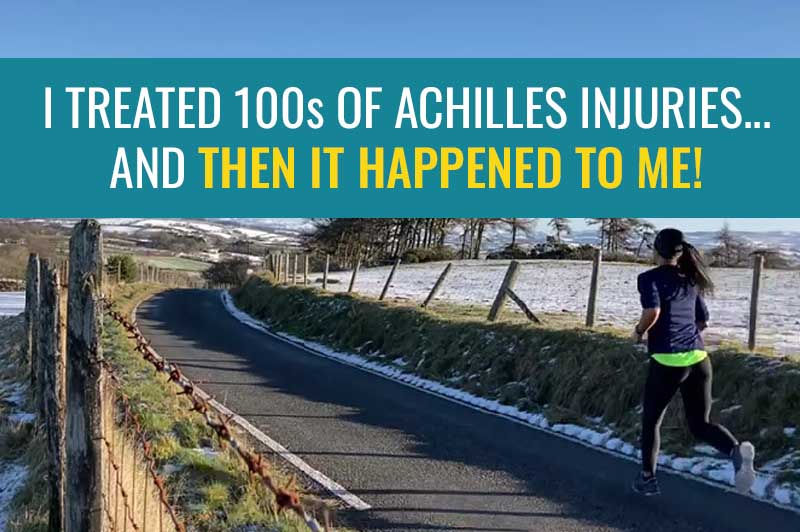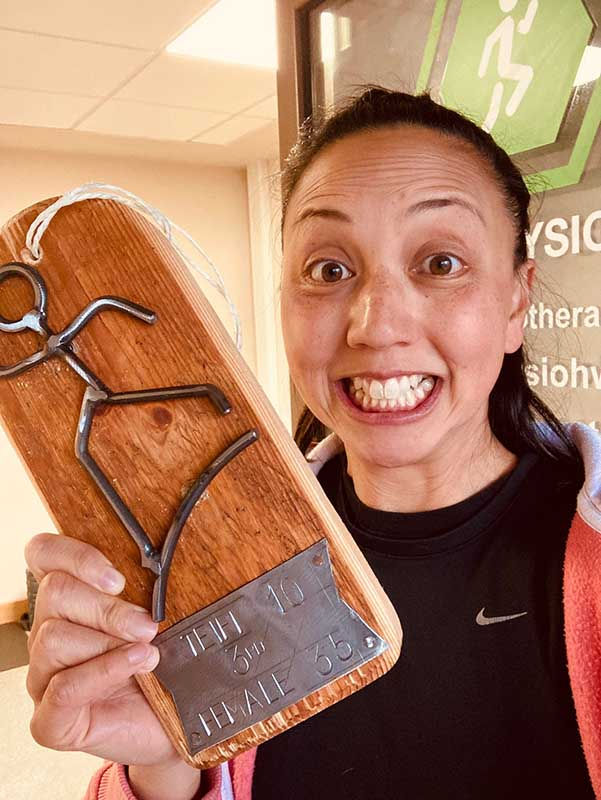I treated hundreds of patients for Achilles injuries – and then it happened to me
- Steph Davies
- Apr 24, 2023
- 10 min read
Updated: Mar 12
A tell-all account by an Achilles specialist physiotherapist and keen runner of the lessons she learned during months of trying to rehab her own insertional Achilles tendinopathy while struggling to return to running. Remember, if you need more help with an Achilles injury, you're welcome to consult one of our team via video call.

As a sports physiotherapist working for TreatMyAchilles.com (our online team specialising in rehab for Achilles tendons), I have worked with over 500 Achilles patients in just the past three years. This included all types of problems in the Achilles area – tendinopathies, tendon tears, bursitis, even gout. Before starting with this fantastic team, I’d also been a qualified sports physio for fifteen years, so by now I’ve seen enough Achilles issues to be pretty confident in rehabbing them.
So, when I started to get gradually worsening pain while running at the back of both my heels, where the Achilles inserts (aka insertional Achilles pain), I was annoyed but not too bothered, as I knew that I would be able to get myself sorted easily. Or did I?!
I want to share with you the reality of rehabbing a crappy Achilles – unfiltered, the inner fight, the exasperation (it has a happy ending though) – to help anyone who feels like they are struggling and feeling like they will never run again!
Just like many of you, running to me is more than exercise. It’s a stress-reliever, and mind-clearer, and free ticket to eat more cake than perhaps I should. My husband and children probably have to put up with much a grumpier me when I can’t run.
Runners are a generally hardy bunch, and will usually put up with aches and pains that come and go as standard. But as a rule, when something starts hurting every run, the sensible thing to do would be to back off running for a while to let it calm down. By doing that, you can normally catch a problem early enough that it won’t keep you out for very long at all, and the recovery is nice and quick.
However, I think we also all have an "invincible" version of ourselves. The one that pushes you through to the finish line when you’d rather stop and keel over. The one that does another hill rep even though you want to vomit. That inner voice that tells you to keep going. That "invincible" version of me managed to convince the "sensible" version of me that "it will probably go away", "it will be fine", and "it’s not that bad and anyway I reeeeally need a run today" ...
What would I tell a patient to do at this stage? Rest it. What did I do? Not rest it. Why? Because resting is boring and also because I thought I was invincible. Only I’m not invincible, and chances are neither are you, and this is how it tends to happen that by the time someone (including me, who should know better) decides to do something about it, it has been weeks or even months already of "running through pain". And then it takes much longer to get better. D’oh.
LESSON 1 – Sometimes we are NOT invincible. If the pain hasn’t gone away in two or three weeks… STOP! Get it looked at by a proper health professional who also understands running and Achilles rehab, and get it sorted. It saves a lot of heartache later on. If it was one of those niggles that was going to get better itself, it would have gone by now. Getting the right advice at this stage will sort it out quicker, so listen to your "sensible" self and get some good early advice.
"Sensible" me eventually won the fight and I rested off running for a couple of weeks, going stir crazy in the meantime, keeping some kind of physical activity up with core, legs, and glutes work, which quite frankly, is really boring. But better than nothing. If time allowed (which it often didn’t) then a bike ride satisfied some of the yearning for cardiovascular activity too.
"Sensible" me was then on a roll. Pain free day-to-day, just a bit of stiffness the first few steps out of bed and the first few steps after sitting. Started on some super easy maintenance heel raise loading – feeling good. Got to the stage where I was questioning whether it really was stiff out of bed or if it was just habit. (If you have to question it, that’s a good sign.) Some days it didn’t even hurt getting up from sitting. Winning.
Progressive strengthening now – made the heel raises harder. I noticed a difference between left and right strength that I hadn’t ever bothered to notice before – and sorted it out. I noticed that some days were more fatiguing than others for no apparent reason, but that’s how life goes. Especially when juggling work, children, and life on a small farm.
The first setback came when I upped the weights for my heel raises again to heavier loads – 16 kg. There was no pain during the exercises but the next morning was bad. I was really annoyed and limping again. There was no good reason for it. "Sensible" me was still in charge, so I rested it and it calmed down after a week and felt fine again. Maybe even a bit better than before. But it felt like a waste of a week.
LESSON 2 – Flare-ups happen! There’s no good reason for it sometimes. You have to deal with it and move on. Don’t throw all your toys out of the pram and declare that you are back to square one again (even if sometimes it feels like it).
I built back up again with the heel-raise work and it’s feeling good at 10-12 kg. Tried 16 kg again. Flared up again the next day. Rested for a week. So, "sod the weights", I thought. It was clearly not working, so I needed to try a different approach.
It seems to be a thing for insertional problems, as this has happened to some of my patients too – it really does feel stronger and more robust from doing the weighted work, but ultimately a change of tactics is needed if one approach is not working.
There’s no point making the same error over and over again – this is why a tailored and individualised approach tends to work better than a rigid "protocol". I sacked off the weights and moved straight onto impact build-up instead.
LESSON 3 – There’s more than one approach to take – if something really isn’t working, there are other tactics to try.
I noticed that my running shoes were a bit worn out and the backing had started to work through the to heel cup – a hard plastic edge was palpable on the shoe exactly where my insertional pain was when my foot sat in that area. I realised that this could be part of the problem and got some new shoes.
LESSON 4 – Check your shoes, especially for insertional Achilles problems.
I also decided that, for good measure, I’d do my rehab impact build-up without shoes on, so I knew that friction/pressure was out of the equation and I could test how much load my actual Achilles could tolerate. It went well and the jumping and footwork drill build-up went fine. Getting closer!
It was time to start a walk-run build-up outdoors in my nice new running shoes. It went well, and I have to say it was ridiculously NOT like exercise because you would come home and feel like you haven’t even done anything. So, I still had to keep going with the hideously boring home circuits too.
Weeks went by and the build-up continued to go OK, aside from the occasional bad day where it’s all stiff again, but couple of days later it felt OK again. This is normal. A good hack at this point is to stay at the same level for longer, rather than necessarily sticking religiously to the progression plan, as it gives your body time to accommodate the new loads and fully adapt – therefore you’re less likely to overload again. I tell my patients this all the time, but it’s not easy because all you want to do is get running!
On went the build-up, until I was eventually running 5 km pain free. Hooray! Pain free! An easy 5 km plod 3 times a week by this point seemed such a pleasure when it didn’t hurt, despite being pretty miniscule. I was so delighted that I stayed at this level for months because it was just so nice running without pain that I didn’t want to jeopardise it in any way.
Then… TURMOIL! Life had other plans! We had a house buying and selling disaster (number five) and a mega stressful time. I was also completing an injection course requiring a 10-hour round trip of driving once a week for three weeks in a row, and one week there was terrible traffic, so it was more like 35 hours’ driving in three weeks, not including all the other daily commutes too. PAIN PAIN PAIN, and I had to stop running.
I’m certain that stress isn’t any good for injuries, and I’m trying to find research to clarify it – there’s certainly plenty to suggest that poor sleep relates to poor recovery. But driving long distances definitely seemed to aggravate it too. Bother.
It took another few weeks without running to settle things enough to resume the 3 times a week 5 km running. There were random niggles on and off but nothing major, so while not entirely pain free at this point, it was perfectly manageable and certainly not getting any worse. So once again, I stayed at 5 km 3 times a week until it really did feel 100% again.
Months later, we finally got the keys to our new place and all the stress alleviated – it felt like I was running on clouds! It was amazing the difference it made. Stress has an awful lot to answer for!
LESSON 5 – Some things are just out of our control, and we have to deal with what’s in front of us day-to-day.
I was on a roll now. Started to increase the weekend run week-by-week – 4 miles, 5 miles, 6 miles, 7 miles. It’s very hilly in our area, so every mile there’s a half a mile climb followed by a pleasurable half a mile flat or downhill. I even joined a social run with the local running club again once a week on and off, and it was such a pleasure to be able to join in. The occasional random pain still haunted me once in a while, but it was never severe, consistent, nor long lasting, so it was fine to ignore. Most of the time is wasn’t there.

Eventually the runners persuaded me at the last minute to enter the local 10-mile road race. It was a fast, flat route (or flat for round here!) and although I hadn’t run 10 miles for a loooooong time (the longest had been 8 hilly miles), I figured that it wasn’t too much of a step up. So I took a punt and entered it anyway.
Funnily enough, as soon as I entered (the race was that weekend), my Achilles started to hurt again! Was I imagining it? Maybe! Stiff getting up from sitting, and in the morning. Not bad (1/10 on the pain scale, maybe 2/10?) – it seemed so coincidental and there was no good reason for a flare-up this time.
I knew that pain is not always a good indicator of the severity of the injury, particularly when you’ve been dealing with the same injury for a long time, and this was one of those situations.
If your mind is blown by this concept, take a look at my colleague Ali’s article here, because she explains this nicely and in more detail. I knew this time it was probably in my head, so I ignored it and ran the race anyway!
And good job I did! I was only aiming for 8 min/mile but flew round (for me!) at 7:33 min/mile and finished in 75 minutes, picking up a third-place age category prize! Not only did nothing hurt all the way round, but there was no Achilles pain the next day, nor the day after, and if anything, it felt stronger and better than it did before.
So there we have it. This is how the rehab can go – not perfect by any means, but the end goal of resuming running was achieved. I didn’t need any injections, shockwave, or surgery. I didn’t need any fancy "quick fix" treatments (which often don’t work anyway), I just needed time, a massive dose of patience, dedication, and consistency. And a new pair of running shoes.

LESSON 6 – It is perfectly possible to be able to run again!
Our team have helped hundreds of people back to sport after their Achilles problems. It’s rarely an easy ride, but if you’re committed, you’ll get there eventually. Please get in touch if you’d like to book a consultation and we can come up with a plan that works for you.
How we can help
Need more help with your Achilles injury? You’re welcome to consult one of the team at TMA online via video call for an assessment of your injury and a tailored treatment plan.
We're all UK Chartered Physiotherapists with Master’s Degrees related to Sports & Exercise Medicine. But at Treat My Achilles we don't just value qualifications; all of us also have a wealth of experience working with athletes across a broad variety of sports, ranging from recreationally active people to professional athletes. You can meet the team here.
This article may contain affiliate links. We might earn a small commission on sales at no extra cost to you.
The terms tendinitis, tendonitis, tendinosis, and tendinopathy mean the same thing for all practical purposes, and we use these interchangeably in our articles.

About the Author
Steph Davies is a chartered physiotherapist with more than 15 years' experience and a Master’s Degree in Sports and Exercise Medicine. You can follow Steph on LinkedIn.












